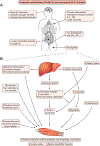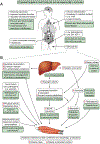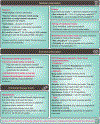Sarcopenia and frailty in decompensated cirrhosis
- PMID: 34039486
- PMCID: PMC9125684
- DOI: 10.1016/j.jhep.2021.01.025
Sarcopenia and frailty in decompensated cirrhosis
Abstract
In patients with decompensated cirrhosis, sarcopenia and frailty are prevalent. Although several definitions exist for these terms, in the field of hepatology, sarcopenia has commonly been defined as loss of muscle mass, and frailty has been broadly defined as the phenotypic manifestation of the loss of muscle function. Prompt recognition and accurate assessment of these conditions are critical as they are both strongly associated with morbidity, mortality, poor quality of life and worse post-liver transplant outcomes in patients with cirrhosis. In this review, we describe the complex pathophysiology that underlies the clinical phenotypes of sarcopenia and frailty, their association with decompensation, and provide an overview of tools to assess these conditions in patients with cirrhosis. When available, we highlight data focusing on patients with acutely decompensated cirrhosis, such as inpatients, as this is an area of unmet clinical need. Finally, we discuss management strategies to reverse and/or prevent the development of sarcopenia and frailty, which include adequate nutritional intake of calories and protein, as well as regular exercise of at least moderate intensity, with a mix of aerobic and resistance training. Key knowledge gaps in our understanding of sarcopenia and frailty in decompensated cirrhosis remain, including best methods to measure muscle mass and function in the inpatient setting, racial/ethnic variation in the development and presentation of sarcopenia and frailty, and optimal clinical metrics to assess response to therapeutic interventions that translate into a reduction in adverse outcomes associated with these conditions.
Keywords: Body composition; Computed tomography; End-stage liver disease; Liver transplant; Muscle function; Muscle mass; Survival.
Copyright © 2021 European Association for the Study of the Liver. Published by Elsevier B.V. All rights reserved.
Conflict of interest statement
Conflict of interest The authors declare no conflicts of interest that pertain to this work. Please refer to the accompanying ICMJE disclosure forms for further details.
Figures






References
-
- Tandon P, Tangri N, Thomas L, Zenith L, Shaikh T, Carbonneau M, et al. A rapid bedside screen to predict unplanned hospitalization and death in outpatients with cirrhosis: a prospective evaluation of the clinical frailty scale. Am J Gastroenterol 2016;111:1759–1767. - PubMed
-
- Cron DC, Friedman JF, Winder GS, Thelen AE, Derck JE, Fakhoury JW, et al. Depression and frailty in patients with end-stage liver disease referred for transplant evaluation. Am J Transplant: Off J Am Soc Transplant Am Soc Transpl Surgeons 2016;16:1805–1811. - PubMed
-
- Lucidi C, Lattanzi B, Di Gregorio V, Incicco S, D'Ambrosio D, Venditti M, et al. A low muscle mass increases mortality in compensated cirrhotic patients with sepsis. Liver Int 2018;38:851–857. - PubMed
Publication types
MeSH terms
Grants and funding
- R56 HL141744/HL/NHLBI NIH HHS/United States
- U01 DK062470/DK/NIDDK NIH HHS/United States
- U01 DK061732/DK/NIDDK NIH HHS/United States
- R01 AA028190/AA/NIAAA NIH HHS/United States
- U01 AA026976/AA/NIAAA NIH HHS/United States
- P50 AA024333/AA/NIAAA NIH HHS/United States
- R01 HS026937/HS/AHRQ HHS/United States
- R01 GM119174/GM/NIGMS NIH HHS/United States
- R21 AR071046/AR/NIAMS NIH HHS/United States
- R01 DK083414/DK/NIDDK NIH HHS/United States
- U01 AA021890/AA/NIAAA NIH HHS/United States
- R01 DK113196/DK/NIDDK NIH HHS/United States
- R01 AG059183/AG/NIA NIH HHS/United States
LinkOut - more resources
Full Text Sources
Other Literature Sources
Medical

